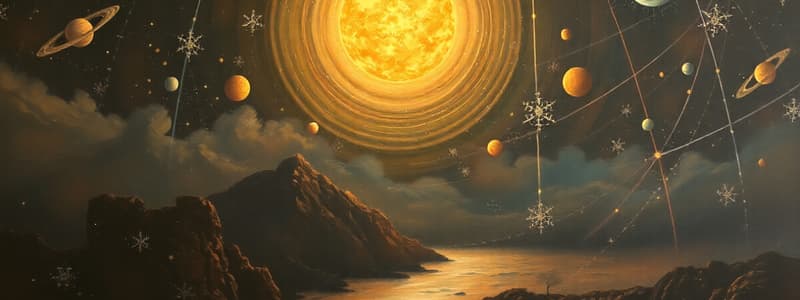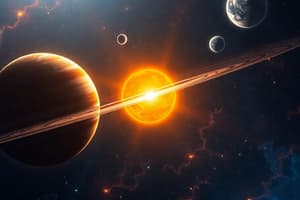Podcast
Questions and Answers
Which planet is the closest to the sun?
Which planet is the closest to the sun?
- Venus
- Mars
- Mercury (correct)
- Earth
Which planet has the longest period to complete one orbit around the sun?
Which planet has the longest period to complete one orbit around the sun?
- Earth
- Jupiter (correct)
- Venus
- Mars
What is the main composition of the inner planets?
What is the main composition of the inner planets?
- Metals
- Ice and water
- Rocks (correct)
- Gases and liquids
How many moons does Earth have?
How many moons does Earth have?
Which planet takes the shortest time to complete one spin on its axis?
Which planet takes the shortest time to complete one spin on its axis?
Which of the following statements is true about the sun?
Which of the following statements is true about the sun?
Which planet is the farthest from the sun?
Which planet is the farthest from the sun?
What is the main reason planets revolve around the sun?
What is the main reason planets revolve around the sun?
What is the angle of inclination of the Earth's axis with its orbital plane?
What is the angle of inclination of the Earth's axis with its orbital plane?
What motion of the Earth is responsible for the changes in seasons?
What motion of the Earth is responsible for the changes in seasons?
What type of mountain is formed due to the folding of the earth's crust?
What type of mountain is formed due to the folding of the earth's crust?
When do the equinoxes occur?
When do the equinoxes occur?
Which mountain range is an example of fold mountains?
Which mountain range is an example of fold mountains?
During which event does the Tropic of Cancer receive direct sunlight?
During which event does the Tropic of Cancer receive direct sunlight?
What are block mountains created from?
What are block mountains created from?
What is the duration of one complete revolution of the Earth around the sun?
What is the duration of one complete revolution of the Earth around the sun?
What is a characteristic feature of a plateau?
What is a characteristic feature of a plateau?
Which phenomenon occurs when neither of the poles is tilted towards the sun?
Which phenomenon occurs when neither of the poles is tilted towards the sun?
Which plateau is known for its rich mineral deposits?
Which plateau is known for its rich mineral deposits?
What creates the phenomena of day and night on Earth?
What creates the phenomena of day and night on Earth?
Which of the following is an example of a volcanic mountain?
Which of the following is an example of a volcanic mountain?
What is a leap year?
What is a leap year?
Which of the following statements about plateaus is true?
Which of the following statements about plateaus is true?
Which mountain range is specifically mentioned as an example of block mountains?
Which mountain range is specifically mentioned as an example of block mountains?
What is the southernmost range of the Himalayan mountains?
What is the southernmost range of the Himalayan mountains?
Which river contributes to the formation of the Ganga-Brahmaputra Delta?
Which river contributes to the formation of the Ganga-Brahmaputra Delta?
What characterizes the Great Indian Desert?
What characterizes the Great Indian Desert?
Which hill ranges are part of the Peninsular Plateau?
Which hill ranges are part of the Peninsular Plateau?
Which coastal plain is located west of the Western Ghats?
Which coastal plain is located west of the Western Ghats?
What type of islands are Lakshadweep and Andaman & Nicobar?
What type of islands are Lakshadweep and Andaman & Nicobar?
What is the main mineral found in the Peninsular Plateau?
What is the main mineral found in the Peninsular Plateau?
Which among the following rivers drains into the Bay of Bengal?
Which among the following rivers drains into the Bay of Bengal?
In which states are Sal trees commonly found?
In which states are Sal trees commonly found?
What adaptation do thorny bushes have to survive in dry areas?
What adaptation do thorny bushes have to survive in dry areas?
At what height does mountain vegetation typically have conical shaped trees?
At what height does mountain vegetation typically have conical shaped trees?
Which species of tree is primarily associated with mangrove forests in the Sunderbans?
Which species of tree is primarily associated with mangrove forests in the Sunderbans?
How do forests contribute to soil conservation?
How do forests contribute to soil conservation?
What type of vegetation is primarily found in dry areas of India?
What type of vegetation is primarily found in dry areas of India?
Which of the following is NOT a benefit provided by forests?
Which of the following is NOT a benefit provided by forests?
Which tree is NOT mentioned as part of mountain vegetation?
Which tree is NOT mentioned as part of mountain vegetation?
Flashcards are hidden until you start studying
Study Notes
The Solar System
- The solar system consists of the sun, eight planets, satellites, asteroids and meteoroids.
- Inner planets are close to the sun, rocky, and include Mercury, Venus, Earth, and Mars.
- Outer planets are far from the sun, are made of gases and liquids, and include Jupiter, Saturn, Uranus and Neptune.
The Sun
- The sun is the center of the solar system.
- It is a huge ball of hot gas.
- The sun is 150 million km away from Earth.
- It provides heat and light and holds the solar system together.
Planets
- There are eight planets in the solar system.
- In order of distance from the sun, they are: Mercury, Venus, Earth, Mars, Jupiter, Saturn, Uranus, and Neptune.
- Planets orbit the sun in fixed paths called orbits.
- Different planets take different amounts of time to complete one revolution around the sun.
Mercury
- Mercury takes 88 days to complete one orbit around the sun.
- One rotation on its axis takes 59 days.
Venus
- Venus takes 225 days to complete one orbit around the sun.
- One rotation on its axis takes 243 days.
Earth
- Earth takes 365 days to complete one orbit around the sun.
- One rotation on its axis takes 1 day.
- Earth has one moon.
Mars
- Mars takes 687 days to complete one orbit around the sun.
- One rotation on its axis takes 1 day.
- Mars has two moons.
Jupiter
- Jupiter takes 11 years and 11 months (about 12 years) to complete one orbit around the sun.
- One rotation on its axis takes 9 hours and 56 minutes.
- Jupiter has about 79 moons.
Motions of Earth
- The Earth's axis is tilted at an angle of 66.5 degrees.
- Rotation is the movement of the Earth on its axis, causing day and night.
- Revolution is the movement of the Earth around the sun in a fixed path called an orbit, causing seasons.
- The Earth's revolution around the sun takes 365 days and 6 hours.
- Leap year is every four years where an extra day is added to February to account for the extra 6 hours.
- Summer Solstice occurs on 21st June when the North Pole is tilted towards the sun, causing summer in the northern hemisphere and winter in the southern hemisphere.
- Winter Solstice occurs on 22nd December when the South Pole is tilted towards the sun, causing summer in the southern hemisphere and winter in the northern hemisphere.
- Equinox occurs twice a year, on 21st March and 23rd September, when the sun's rays fall directly on the equator, causing equal day and night across the entire earth.
- Spring Season occurs in the northern hemisphere between the March equinox and the June solstice.
- Autumn Season occurs in the northern hemisphere between the September equinox and the December solstice.
Types of Mountains
- Fold Mountains form when the Earth's crust folds due to pressure. Examples include the Himalayas, Alps, Aravali, Appalachians and Ural Mountains.
- Block Mountains are formed when large areas of land are broken and displaced vertically. Examples include the Rhine Valley and the Vosges Mountains.
- Volcanic Mountains form from volcanic activity. Examples include Mount Kilimanjaro in Africa and Mount Fujiyama in Japan.
Plateaus
- Plateaus are elevated flatlands that stand above the surrounding area.
- Plateaus are rich in mineral deposits, have numerous waterfalls and have fertile land for agriculture.
- Examples include the Deccan plateau in India, the East African Plateau, and the Western plateau of Australia.
India: Physical Divisions
- The Northern Indian Plains were formed by alluvial deposits laid down by the Indus, Ganga, and Brahmaputra rivers.
- The plains are fertile and support a high concentration of people.
- The Great Indian Desert is a dry and hot, sandy stretch of land with little vegetation.
- The Peninsular Plateau is triangular in shape, uneven terrain and rich in minerals. It contains several mountain ranges including the Aravali Hills, Vindhyas, Satpuras, Western Ghats, and Eastern Ghats.
- The Coastal Plains are found on both the east and west coasts of India.
- The Islands of India include Lakshadweep in the Arabian Sea and Andaman and Nicobar in the Bay of Bengal.
India: Climate, Vegetation, and Wildlife
- Tropical Deciduous Forests are found in areas with distinct wet and dry seasons. They have trees that shed their leaves during the dry season.
- Thorny Bushes are found in dry areas of the country, including Rajasthan, Punjab, Haryana, Gujarat and the Eastern Slopes of the Western Ghats. The leaves are spines to reduce water loss. These forests are adapted to arid conditions.
- Mountain Vegetation varies with altitude. Coniferous forests of chir, pine, and deodar trees grow between 1,500-2,500 meters.
- Mangrove Forests are found in saline water environments like the Sundarbans in West Bengal and the Andaman and Nicobar Islands. The Sundari tree is an important species in these forests.
Why are Forests Necessary?
- Forests are essential for life on Earth because they produce oxygen and absorb carbon dioxide.
- They provide timber, fuelwood, fodder, medicinal plants, and habitat for wildlife.
- Forest roots bind the soil and prevent soil erosion.
Studying That Suits You
Use AI to generate personalized quizzes and flashcards to suit your learning preferences.




